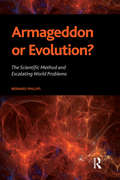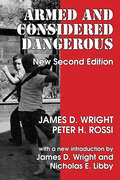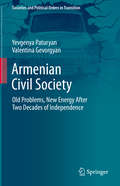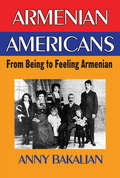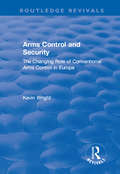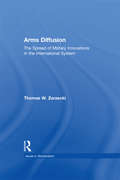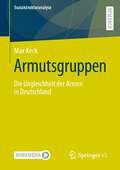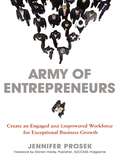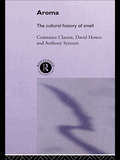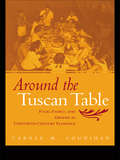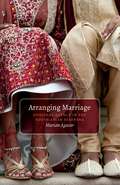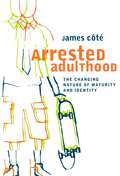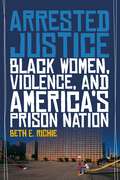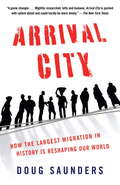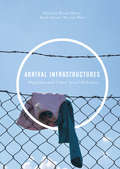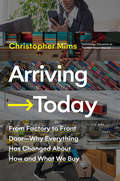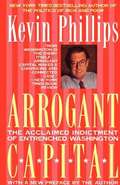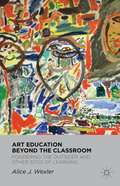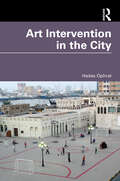- Table View
- List View
Armageddon or Evolution?: The Scientific Method and Escalating World Problems
by Bernard S PhillipsWe are currently experiencing a wide range of evolving problems that threaten us with extinction. However, Phillips argues that we have the capacity-with the aid of a broad approach to the scientific method that builds on Mills's concept of "the sociological imagination"-to confront these problems ever more effectively. This book develops and builds upon new methods for addressing such social problems as global warming, terrorism, growing inequalities, and others. Phillips reveals procedures for achieving conscious evolution by uncovering fundamental assumptions and their contradictions and by moving toward alternative assumptions that promise to resolve these contradictions.
Armed and Considered Dangerous: A Survey of Felons and Their Firearms (Social Institutions And Social Change Ser.)
by Peter H. RossiArmed and Considered Dangerous is a book about "bad guys" and their guns. But Wright and Rossi contend that for every suspected criminal who owns and abuses a firearm, a hundred or more average citizens own guns for sport, for recreation, for self-protection, and for other reasons generally regarded as appropriate or legitimate. Armed and Considered Dangerous is the most ambitious survey ever undertaken of criminal acquisition, possession, and use of guns.There are vast differences between the average gun owner and the average gun-abusing felon, but the analyses reported here do not suggest any obvious way to translate these differences into gun control policies. Most policy implications drawn from the book are negative in character: this will not work for this reason, that will not work for that reason, and so on. When experts are asked, "Okay, then what will work?" they usually fall back on the old warhorses of poverty, the drug problem, or the inadequate resources of the criminal justice system, and otherwise have little to say. This is not a failure of social science. It simply asks more of the data than the data were ever intended to provide.Several of Wright and Rossi's findings have become "coin of the realm" in the gun control debate, cited frequently by persons who have long since forgotten where the data came from or what their limitations are. Several other findings, including many that are important, have been largely ignored. Still other findings have been superseded by better and more recent data or rendered anachronistic by intervening events. With the inclusion of a new introduction detailing recent statistics and updated information this new edition of Armed and Considered Dangerous is a rich source of information for all interested in learning about weapon behavior and ownership in America.
Armenian Civil Society: Old Problems, New Energy After Two Decades of Independence (Societies and Political Orders in Transition)
by Yevgenya Paturyan Valentina GevorgyanThis book analyzes Armenian civil society in the context of post-communist democratization. It explores persistent challenges to civic engagement under Armenia’s semi-authoritarian regime, and also highlights success stories of public mobilization and social impact. Drawing on a broad range of methods and empirical sources, the book provides a comprehensive overview of the re-emerging diversity of Armenian civil society: from formal organizations to spontaneous activism. It combines a country-level analysis of broad patterns in the country’s political culture with the life stories of individual agents of change, contrasting public apathy with young activists’ enthusiasm. By exploring mobilization strategies and narratives in Armenian civil society, the book provides valuable new insights into the roots of the mass public uprising in spring 2018.
Armenian-Americans: From Being to Feeling American
by Anny BakalianAssimilation has been a contentious issues for most immigrant groups in the United States. The host society is assumed to lire immigrants and their descendants away from their ancestral heritage. Yet, in their quest for a "better" life, few immigrants intentionally forsake heir ethnic identity; most try to hold onto their culture by transplanting their traditional institutions and recreating new communities in America. Armenian-Americans are no exception. Armenian-Americans have been generally overlooked by census enumerators, survey analysts, and social scientists because of their small numbers and relative dispersion throughout the United States. They remain a little-studied group that has been called a "hidden minority." Armenian Americans fills this significant gap. Based on the results of an extensive mail questionnaire survey, in-depth interviews, and participant observation of communal gatherings, this book analyzed the individual and collective struggles of Armenian-Americans to perpetuate their Armenian legacy while actively seeking new pathways to the American Dream. This volume shows how men and women of Armenian descent become distanced from their ethnic origins with the passing of generations. Yet assimilation and maintenance of ethnic identity go hand-in-hand. The ascribed, unconscious, compulsive Armenianness of the immigrant generation is transformed into a voluntary, rational, situational Armenianness. The generational change is from being Armenian to feeling Armenian. The Armenian-American community has grown and prospered in this century. Greater tolerance of ethnic differences in the host society, the remarkable social mobility of many Armenian-Americans and the influx of large numbers of new immigrants from the Middle East and Soviet bloc in recent decades have contributed to this development. The future of this community, however, remains precarious as it strives to adjust to the ever changing social, economic, and political conditions affec
Arms Control and Security: The Changing Role of Conventional Arms Control in Europe (Routledge Revivals Ser.)
by Kevin WrightThis title was first published in 2000: The aim of this text is to explore conventional arms control in Europe. The early chapters provide a primarily historical perspective, looking at the context, foundations, main provisions and institutional structure of the main agreements. The later chapters explore the continuing and likely future roles of the OSCE and NATO in the arms control process. The final chapters examine more contemporary developments by looking at the Adapted CFE Treaty and Vienna Documents agreed at the OSCE Istanbul Summit in November 1998 and the challenges posed to existing arrangements by the changing and emergent security threats that potentially face Europe.
Arms Diffusion: The Spread of Military Innovations in the International System (Issues in Globalization)
by THomas W. ZarzeckiWeapons proliferation is one of the most pressing global concerns following the end of the Cold War. Despite the absence of an overarching superpower conflict, armaments and related technologies have continued to spread throughout the international system. This has been particularly true in areas like East Asia and the Middle East, where the traditional two party arms races are not readily apparent. This text addresses these concerns and shortcomings using data on fourteen specific military technological innovations that diffused throughout the international system from 1960 to 1997.
Armut im jungen Erwachsenenalter und der Wandel von Arbeitsmarkt, Wohlfahrtsstaat und Haushalten
by Sebastian LinkSebastian Link geht in diesem Buch der Frage nach, welche Auswirkungen mit dem Erwerbseinstiegsprozess verbundene Risiken (Arbeitslosigkeit, Niedriglohnbeschäftigung) und atypische Beschäftigungsverhältnisse auf die Armutsbetroffenheit junger Erwachsener in Deutschland haben. Mithilfe von Quer- und Längsschnittanalysen auf Basis des Sozio-Oekonomischen Panels zeigt er, dass nicht in erster Linie das gehäufte Auftreten von Erwerbsrisiken und atypischer Beschäftigung zu einem Armutsanstieg bei jungen Erwachsenen geführt hat, sondern die Verstärkung ihrer negativen finanziellen Folgen. Diese Verstärkung steht in einem Zusammenhang mit dem abnehmenden Schutz junger Erwachsener vor Armut durch Wohlfahrtsstaat und Haushalte.
Armut, Ausgrenzung und die Neugestaltung des Sozialen: Die Lebensmittelausgaben der ‚Tafeln‘ in Deutschland
by Holger SchonevilleDas Buch stellt eine empirische Analyse der subjektiven Bedeutung von Armut und sozialer Aus-grenzung innerhalb eines gewandelten sozialstaatlichen Arrangements dar. Es zeigt auf, dass von Armut betroffene Menschen ständig damit konfrontiert sind, dass sie von ihren eigenen Idealen, Wünschen und Überzeugungen abweichen und diese nicht realisieren können. Zugleich wird gezeigt, dass die Entstehung und Etablierung von Hilfsangeboten der ‚Tafel‘ auf die Existenz von Armut innerhalb der bundesrepublikanischen Gesellschaft verweist und ein Symbol der Transformation des Sozialstaats darstellt. Während die Nutzer*innen der ‚Tafeln‘ auf die Hilfen angewiesen sind, versetzen diese sie zugleich jedoch nicht in der Lage, die Armutssituation zu überwinden.
Armutsbekämpfung durch Entwicklungszusammenarbeit: Anspruch – Wirklichkeit – Perspektiven
by Frank BlissDieses Buch gibt eine Einführung in die Theorie und insbesondere die Praxis der entwicklungspolitischen Zusammenarbeit. Der Fokus liegt dabei auf der Armutsbekämpfung, d.h., das (häufig leider nur eingeschränkte) Bemühen von Regierungen der sogenannten Entwicklungsländer, die Massenarmut mit finanzieller und technischer Unterstützung vor allem der reichen Industrieländer zu reduzieren. Nach einer Problematisierung der zumeist unterschätzen Armutszahlen sowie Darlegung der Gründe für Armut und ihre Verstetigung erfolgt ein kurzer Überblick über die allgemeine Praxis der Entwicklungszusammenarbeit (Akteure, Gelder, Verfahren). Zahlreiche Projektbeispiele zeigen bisherige erfolgreiche wie auch weniger erfolgreiche Lösungen sowie die notwendigen Reformen bei der Armutsbekämpfung.Es werden die wichtigsten Bereiche der Zusammenarbeit berücksichtigt: die „klassischen“ Sektoren, angefangen von Bildung und Gesundheitsversorgung über den Ressourcenschutz, die Landwirtschaft, die Beschäftigungsförderung und natürlich die ganz besonders wichtige Trinkwasserversorgung. Sehr praktische und einleuchtende Beispiele beziehen sich auch auf die Regierungsarbeit („gute Regierungsführung“) und die Infrastruktur, denn Korruption kann alle Entwicklung verhindern und ohne wenigstens eine Piste vom Dorf zum Markt kann selbst ein Kleinbauer in Afrika nichts auf dem Markt verkaufen. Eine Reihe von mit Fotos dokumentierten Fallstudien runden das Praxisbild ab.
Armutsgruppen: Die Ungleichheit der Armen in Deutschland (Sozialstrukturanalyse)
by Max KeckDieses Buch beschäftigt sich auf Grundlage einer Kritik der Forschungspraxis quantitativer Armutsforschung mit der Heterogenität der Armutspopulation in Deutschland. Dies geschieht entlang von Armutsgruppen im Zeitraum von 1984 bis 2018 und unter Verwendung des Sozioökonomischen Panels (SOEP). Hierbei spielt eine kombinierte Analyse von Risikopositionen in der Erwerbsarbeit, in der sozialstaatlichen Umverteilung und in Haushalten eine Rolle. Die Ergebnisse der Arbeit sind sowohl für die Armutsforschung als auch für die Sozialberichterstattung interessant. Das Buch bietet aber auch für Praktiker*innen in politischen Feldern spannende Erkenntnisse.
Army Spouses: Military Families during the Global War on Terror
by Morten G. EnderDistilled from nearly two hundred interviews, conducted from the 2003 invasion of Iraq on, Army Spouses marshals an incredible breadth of individual experiences, range of voices, insider access, and theoretical expertise to tell the story of US Army husbands and wives and their families during wartime in this century.Morten Ender offers the first contemporary study of the emotional cycle of deployment and its impact on military families in the post-9/11 world. Military spouses, as he shows, operate both near and far from the front lines, serving on the home front to support combat service in the so-called Global War on Terror that has intimately bound together soldiers, families, the military institution, the state, and society. He paints a vivid picture of army spouses’ range of responses to deployment separations that illuminates the deep sacrifices that soldiers, veterans, and their families have made over the past twenty years.
Army of Entrepreneurs: Creating an Engaged and Empowered Workforce for Exceptional Business Growth
by Jennifer ProsekProsek (founder and CEO of a public relations firm) shares her secrets to creating a successful business. Her main point is that each employee must feel like the owner of the business, thus creating motivation and a positive attitude. Part one of the text introduces and discusses Prosek's business model. Part two tackles the mechanics of implementing her strategies into one's own business, such as training for all employees, and the use of technology. Part three offers a conclusion and a chapter devoted to addressing naysayers. An appendix listing additional resources is included. Annotation ©2011 Book News, Inc. , Portland, OR (booknews. com)
Aroma: The Cultural History of Smell
by Constance Classen David Howes Anthony SynnottSmell is a social phenomenon, given particular meanings and values by different cultures. Odours form the building blocks of cosmologies, class hierarchies, and political odours. They can enforce social structures or transgress them, unite people or divide them, empower or disempower. The authors argue that the sociology of smell is repressed in the modern West, and its social history ignored. This book breaks the "olfactory silence" of modernity. It offers the first comprehensive exploration of the cultural role of odours in Western history - from antiquity to the present. It also covers a wide variey of non-Western societies. Its topics range from the medieval concept of the "odour of sanctity", to the aromatherapies of South America, and from olfactory stereotypes of gender and ethnicity in the modern West to the role of smell in postmodernity. Its subject matter will fascinate anyone who likes to nose around in the inner workings of culture.
Around the Tuscan Table: Food, Family, and Gender in Twentieth Century Florence
by Carole M. CounihanIn this delicious book, noted food scholar Carole M. Counihan presents a compelling and artfully told narrative about family and food in late 20th-century Florence. Based on solid research, Counihan examines how family, and especially gender have changed in Florence since the end of World War II to the present, giving us a portrait of the changing nature of modern life as exemplified through food and foodways.
Around the World in 30 Years: Life as a Cultural Anthropologist
by Barbara Gallatin AndersonAnderson brings to life a range of cultures from the tribal Hmong to a United States military base. With humor and a precision born of hands-on familiarity with the regions involved, she draws the reader into startlingly real identification with other people's worlds: France, Denmark, Thailand, India, Morocco, Japan, Corsica, China, Russia, and the United States. Collectively, these chapters give us insight into a gamut of anthropological themes, the challenges of applied fieldwork, and the impact of change on world cultures.
Arranging Marriage: Conjugal Agency in the South Asian Diaspora
by Marian AguiarThe first critical analysis of contemporary arranged marriage among South Asians in a global context Arranged marriage is an institution of global fascination—an object of curiosity, revulsion, outrage, and even envy. Marian Aguiar provides the first sustained analysis of arranged marriage as a transnational cultural phenomenon, revealing how its meaning has been continuously reinvented within the South Asian diaspora of Britain, the United States, and Canada. Aguiar identifies and analyzes representations of arranged marriage in an interdisciplinary set of texts—from literary fiction and Bollywood films, to digital and print media, to contemporary law and policy on forced marriage.Aguiar interprets depictions of South Asian arranged marriage to show we are in a moment of conjugal globalization, identifying how narratives about arranged marriage bear upon questions of consent, agency, state power, and national belonging. Aguiar argues that these discourses illuminate deep divisions in the processes of globalization constructed on a fault line between individualist and collectivist agency and in the process, critiques neoliberal celebrations of &“culture as choice&” that attempt to bridge that separation. Aguiar advocates situating arranged marriage discourses within their social and material contexts so as to see past reductive notions of culture and grasp the global forces mediating increasingly polarized visions of agency.
Arrested Adulthood: The Changing Nature of Maturity and Identity
by James E. CoteAn examination into the social influences that have prolonged youth in today's adultsWhy are today's adults more like adolescents, in their dress and personal tastes, than ever before? Why do so many adults seem to drift and avoid responsibilities such as work and family? As the traditional family breaks down and marriage and child rearing are delayed, what makes a person an adult?Many people in the industrial West are simply not "growing up" in the traditional sense. Instead, they pursue personal, individual fulfillment and emerge from a vague and prolonged youth into a vague and insecure adulthood. The transition to adulthood is becoming more hazardous, and the destination is becoming more difficult to reach, if it is reached at all. Arrested Adulthood examines the variety of young people's responses to this new situation. James E. Côté shows us adults who allow the profit-driven industries of mass culture to provide the structure that is missing, as their lives become more individualistic and atomized. He also shows adults who resist anomie and build their world around their sense of personal connectedness to others. Finally, Côté provides a vision of a truly progressive society in which all members can develop their potentials apart from the influence of the market. In so doing, he gives us a clearer vision of what it means to be an adult and makes sense of the longest, but least understood period of the life course.
Arrested Justice: Black Women, Violence, and America’s Prison Nation
by Beth E. RichieIlluminates the threats Black women face and the lack of substantive public policy towards gendered violenceBlack women in marginalized communities are uniquely at risk of battering, rape, sexual harassment, stalking and incest. Through the compelling stories of Black women who have been most affected by racism, persistent poverty, class inequality, limited access to support resources or institutions, Beth E. Richie shows that the threat of violence to Black women has never been more serious, demonstrating how conservative legal, social, political and economic policies have impactedactivism in the U.S.-based movement to end violence against women. Richie argues that Black women face particular peril because of the ways that race and culture have not figured centrally enough in the analysis of the causes and consequences of gender violence. As a result, the extent of physical, sexual and other forms of violence in the lives of Black women, the various forms it takes, and the contexts within which it occurs are minimized—at best—and frequently ignored. Arrested Justice brings issues of sexuality, class, age, and criminalization into focus right alongside of questions of public policy and gender violence, resulting in a compelling critique, a passionate re-framing of stories, and a call to action for change.
Arrival City: The Final Migration and Our Next World
by Doug SaundersLook around: the largest migration in human history is under way. For the first time ever, more people are living in cities than in rural areas. Between 2007 and 2050, the world's cities will have absorbed 3.1 billion people. Urbanization is the mass movement that will change our world during the twenty-first century, and the "arrival city" is where it is taking place. The arrival city exists on the outskirts of the metropolis, in the slums, or in the suburbs; the American version is New York's Lower East Side of a century ago or today's Herndon County, Virginia. These are the places where newcomers try to establish new lives and to integrate themselves socially and economically. Their goal is to build communities, to save and invest, and, hopefully, move out, making room for the next wave of migrants. For some, success is years away; for others, it will never come at all. As vibrant places of exchange, arrival cities have long been indicators of social health. Whether it's Paris in 1789 or Tehran in 1978, whenever migrant populations are systematically ignored, we should expect violence and extremism. But, as the award-winning journalist Doug Saunders demonstrates, when we make proper investments in our arrival cities--through transportation, education, security, and citizenship--a prosperous middle class develops. Saunders takes us on a tour of these vital centers, from Maryland to Shenzhen, from the favelas of Rio to the shantytowns of Mumbai, from Los Angeles to Nairobi. He uncovers the stories--both inspiring and heartbreaking--of the people who live there, and he shows us how the life or death of our arrival cities will determine the shape of our future.From the Hardcover edition.
Arrival Infrastructures: Migration and Urban Social Mobilities
by Bruno Meeus Karel Arnaut Bas Van HeurThis volume introduces a strategic interdisciplinary research agenda on arrival infrastructures. Arrival infrastructures are those parts of the urban fabric within which newcomers become entangled on arrival, and where their future local or translocal social mobilities are produced as much as negotiated. Challenging the dominance of national normativities, temporalities, and geographies of “arrival,” the authors scrutinize the position and potential of cities as transnationally embedded places of arrival. Critically interrogating conceptions of migrant arrival as oriented towards settlement and integration, the volume directs attention to much more diverse migration trajectories that shape our cities today. Each chapter examines how migrants, street-level bureaucrats, local residents, and civil society actors build—with the resources they have at hand—the infrastructures that accommodate, channel, and govern arrival.
Arriving Today: From Factory to Front Door -- Why Everything Has Changed About How and What We Buy
by Christopher MimsThe Wall Street Journal technology columnist reveals the fascinating story behind the misleadingly simple phrase shoppers take for granted—“Arriving Today”—in this eye-opening investigation into the new rules of online commerce, transportation, and supply chain management.We are at a tipping point in retail history. While consumers are profiting from the convenience of instant gratification, rapidly advancing technologies are transforming the way goods are transported and displacing workers in ways never before seen.In Arriving Today, Christopher Mims goes deep, far, and wide to uncover how a single product, from creation to delivery, weaves its way from a factory on the other side of the world to our doorstep. He analyzes the evolving technologies and management strategies necessary to keep the product moving to fulfill consumers’ demand for “arriving today” gratification. Mims reveals a world where the only thing moving faster than goods in an Amazon warehouse is the rate at which an entire industry is being gutted and rebuilt by innovation and mass shifts in human labor practices. He goes behind the scenes to uncover the paradoxes in this shift—into the world’s busiest port, the cabin of an 18-wheeler, and Amazon’s automated warehouses—to explore how the promise of “arriving today” is fulfilled through a balletic dance between humans and machines. The scope of such large-scale innovation and expended energy is equal parts inspiring, enlightening, and horrifying. As he offers a glimpse of our future, Mims asks us to consider the system’s vulnerability and its resilience, and who shoulders the burden, as we hurtle toward a fully automated system—and what it will mean when we are there.
Arrogant Capital: Washington, Wall Street, and the Frustration of American Politics
by Kevin PhillipsEveryone knows that Washington is completely out of touch with the rest of the country. Now Kevin Phillips, whose bestselling books have prophesied the major watersheds of American party politics, tells us why. Washington - mired in bureaucracy, captured by the money power of Wall Street, and dominated by 90,000 lobbyists, 60,000 lawyers, and the largest concentration of special interests the world has ever seen - has become the albatross that Thomas Jefferson and our other Founding Fathers feared: a swollen capital city feeding off the country it should be governing. Throughout most of our history, the genius of American politics was that ballot revolutions every generation swept out failed establishments and created new ones. Now that can no longer happen. Feared and even hated by a majority of the citizenry, "Permanent Washington" has dug in. Using history as a chilling warning, Kevin Phillips parallels the present atrophy to that of formerly mighty and arrogant capitals like Rome, Madrid, and Amsterdam.,Unchecked, Washington will - like other great powers before it - lead the country to its inevitable decline and fall. To work again, Washington must be purged and revitalized. In his unique blueprint for a political upheaval, Kevin Phillips puts Washington on notice by sounding a cry for immediate action, offering us a wide variety of remedies - some quasi-revolutionary, others more moderate, but all sure to be controversial.
Art Education Beyond the Classroom
by Alice J. WexlerBy focusing on children and adults with disabilities, each contributor offers critical research which challenges the non-transferable divide between us and them , encouraging art teachers, therapists, critics, and general readers alike to uncover their biases regarding the nature of art and education.
Art Intervention in the City
by Hadas OphratThis book focuses on the phenomenon of art intervention—an expression of local initiatives by artists, collectives, and art centers wishing to influence the design of the space or make a change in its lifestyle. It pertains not only to acts of protest, but also to the creation of a new civil and political situation in which artists acknowledge their ability to constitute foci of power. These are reflected in acts such as squatting in abandoned buildings, restoring and redistributing them according to principles of social justice; mapping the city based on alternative parameters, such as revealing venues of collective memory or exposing the city's backyard; creating outdoor urban art galleries; and creating temporary architecture and alternative solutions in order to deal with the challenges we face in times of epidemic and environmental crisis. The art intervention phenomenon has intensified since the mid-1990s, so much so that even local authorities the world over have begun to adopt activist and artistic practices. Due to the intensive urbanization processes and current global threats, the creative trends and means surveyed in the book are crucial. This book will interest researchers, planners, urban planners, architects, social activists, local authority executives, art centers, artists, and designers.
Art Rebels: Race, Class, and Gender in the Art of Miles Davis and Martin Scorsese
by Paul LopesHow creative freedom, race, class, and gender shaped the rebellion of two visionary artistsPostwar America experienced an unprecedented flourishing of avant-garde and independent art. Across the arts, artists rebelled against traditional conventions, embracing a commitment to creative autonomy and personal vision never before witnessed in the United States. Paul Lopes calls this the Heroic Age of American Art, and identifies two artists—Miles Davis and Martin Scorsese—as two of its leading icons.In this compelling book, Lopes tells the story of how a pair of talented and outspoken art rebels defied prevailing conventions to elevate American jazz and film to unimagined critical heights. During the Heroic Age of American Art—where creative independence and the unrelenting pressures of success were constantly at odds—Davis and Scorsese became influential figures with such modern classics as Kind of Blue and Raging Bull. Their careers also reflected the conflicting ideals of, and contentious debates concerning, avant-garde and independent art during this period. In examining their art and public stories, Lopes also shows how their rebellions as artists were intimately linked to their racial and ethnic identities and how both artists adopted hypermasculine ideologies that exposed the problematic intersection of gender with their racial and ethnic identities as iconic art rebels.Art Rebels is the essential account of a new breed of artists who left an indelible mark on American culture in the second half of the twentieth century. It is an unforgettable portrait of two iconic artists who exemplified the complex interplay of the quest for artistic autonomy and the expression of social identity during the Heroic Age of American Art.
